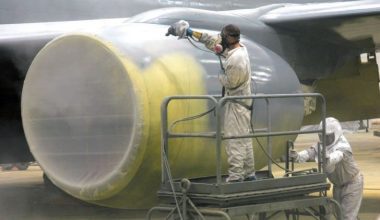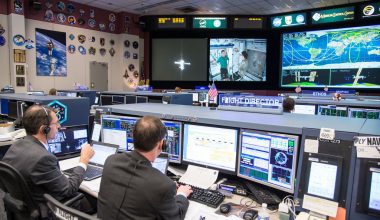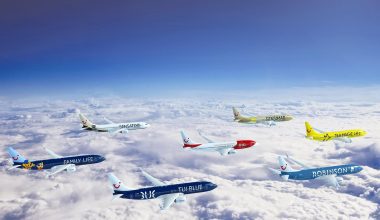The evolution of electronic communications equipment is nearly as same as the evolution of aircraft. The radio age came about almost simultaneously when the Wright Brothers took off their aircraft. Traditional aircraft communications are based on analog voice (Signal with a continuously and smoothly varying amplitude or frequency) on either Very High Frequency (VHF) or High Frequency (HF) radio waves. Currently, aircraft are equipped with communication technologies that transport data via satellite plus while on the ground, mobile communication, etc. This is currently the primary means for pilots to communicate with various Air Traffic Control (ATC) entities for the coming years. So how are these communication performed then?

High Frequency (HF)
High frequency (HF) or decameter band is the designation of the International Telecommunications Union (ITU) for the range of radiofrequency electromagnetic waves (radio waves) between 3 and 30 megahertz (MHz). The band is used by international shortwave radio stations (3.95–25.82 MHz) in aviation communications, government time stations, weather stations, amateur radio, citizen band services, etc.
Read More

High Frequency (HF) is routinely continuing to work for thousands of miles for two specific reasons. HF signals are reflected earth by ionized layers 60 to 200 miles above the earth’s modern. HF transmitters using a single-sideband, SSB process that puts virtually all of the transmitter’s power in the audio signal, providing about eight times the “talking” power of the basic am transmitter. Radio communication with HF can be difficult. For reflection, HF radio signal transmission is strongly contingent on the multi-layer ionosphere. The motion of ultraviolet radiation from the sun shapes these layers mainly. The efficiency of the ionosphere as a reflector changes concerning the amount of sunlight passing through it.
Read More
Typical aircraft High-Frequency communication systems consist of: control head located in the cockpit, HF transceiver and power amplifier located in the radio rack, and antenna coupler located in the immediate area of the antenna. The HF antennas used on the older aircraft consisted simply of an insulated copper wire extended from the fuselage utilizing an electric motor that adjusted the resonant length of the antenna to match the frequency transmitted or received. The HF system on an aircraft provides two-way voice communication with or digitally coded signals for ground stations or other aircraft. The HF radio control panel is located where it is easily accessible to the pilot or copilot. The HF transceiver is installed in an electronic device rack and is remotely controlled from the control unit on the flight deck. The HF system consists of HF receiver-transmitter, HF control unit, antenna coupler system, antenna, and receiver-transmitter.
Very High Frequency (VHF)
Very high frequency (VHF) is the designation of the International Telecommunications Union (ITU) for the range of radiofrequency electromagnetic waves (radio waves) from 30 to 300 megahertz (MHz). In aviation 108–118 MHz, the VOR and the Instrument Landing System Localizer are used as air navigation beacons. And then, 118–137 MHz is used as airband (the VHF radio spectrum used in civil aviation) for air traffic control, AM, and 121.5 MHz for emergency frequency.
VHF communication systems are the most widely used systems for maintaining contact between ground and aircraft. This uses the “Line Of Sight” transmission, which translates to a range of approximately thirty miles for aircraft operating at 1,000 feet above ground level, or approximately 135 miles for aircraft operating at 10,000 feet.

VHF communication systems consist of a VHF transceiver, control head, antenna, and an aircraft audio system interface for access to a microphone and a cockpit speaker. VHF communication transmitters provide AM voice communication between aircraft and ground stations or between aircraft. Light aircraft VHF communications equipment is usually paired with a radio set up for VHF navigation (NAV). The VHF transceiver is a solid-state or digital device capable of receiving or transmitting either of the COMM frequency range’s 720 channels. The VHF antennas are low-drag stub units that extend from the top and bottom center of the aircraft. By carefully calibrated tuning line lengths, these antennas are linked to their respective transmission lines. Both transmitting and receiving antennas are used.
Transponder
A transponder is an electronic device that generates a response when it receives a radio-frequency interrogation. Aircraft shall have transponders to assist in the identification of transponders on air traffic control radar. Collision prevention systems have been developed to use transponder transmissions to detect aircraft at risk of colliding with each other.

Transponders were first used to allow military authorities to identify friendly aircraft that transmitted a coded signal when interrogated by military radar. Subsequently, transponders have become widely used in both civil and military aviation.
Civil aircraft may be equipped with transponders capable of operating in a variety of modes:
- Mode A equipment transmits an identification code only.
- Mode C equipment enables the ATCO to see the aircraft’s altitude or flight level automatically.
- Mode S equipment has altitude capability and also enables data exchange.
Mode C or S is a mandatory requirement for many busy areas of controlled airspace. Some of the universally applicable transponder codes are:
- 7500 for aircraft hijacking
- 7600 for Radio failure or lost communication
- 7700 for Emergency
There are also different codes according to specific countries.






